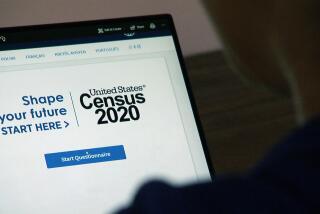CENSUS : Demographers Seek Methods to Count On in the Year 2000
- Share via
WASHINGTON — As the 1990 census draws to a close, government officials and demographers are discussing how best to conduct the census in the year 2000 and beyond.
Amid continuing controversy over whether the latest census should be adjusted to offset an expected undercount of minorities and poor Americans, many question if traditional enumeration procedures will work as well in the future as they have in the past.
Indeed, many demographers say problems associated with the 1990 census reflect a population that has become too mobile and too uncooperative to allow the government to rely on mail-in surveys and door-to-door interviews to count every person.
BACKGROUND: Despite an expensive publicity campaign to persuade Americans to cooperate, some major cities reported that entire communities went uncounted. Participation fell off so sharply in many urban areas that waves of mayors, governors and congressional leaders complained repeatedly of an undercount before the final census figures were released.
By the Census Bureau’s own estimates, more than a third of the 100 million census forms were not returned, requiring a federal infusion of $180 million to augment the agency’s door-to-door canvassing.
In the next decade, critics argue, the nation’s residents will be even more diverse and less tolerant of government queries into their affairs, rendering business as usual for census workers virtually impossible.
Supporters of current enumeration practices say the government is bound by the Constitution to conduct a traditional head count of the nation’s inhabitants every 10 years for congressional redistricting purposes.
They also argue that a person-by-person count is the only way to obtain information in remote and sparsely inhabited areas. A less comprehensive procedure could endanger the bureau’s reputation for collecting accurate demographic data.
Even supporters agree, however, that the Census Bureau fails to count everyone and that low-income, minority and homeless Americans are most often undercounted.
PROPOSAL: Dr. Barbara E. Bailar, executive director of the American Statistical Assn., urges the government to employ scientific sampling surveys to determine an estimate of the population that falls into the hard-to-count categories.
Bailar, a former Census Bureau official, points to the problems associated with last year’s census as proof that voluntary participation in the once-in-a-decade event is unlikely to count some people fearful of government intrusion.
“Anyone who thinks we can accurately get a head count of every person in America is whistling in the dark,” she said, noting that the traditional count still must be conducted for legal and practical reasons. “But we have to build into it a sample of people you just can’t count in the usual way.”
The sentiment expressed by Bailar seems to be gaining political support.
“The unavoidable legacy of this highly scrutinized census is that Americans no longer cling to the myth that the census counts represent an exact accounting of the population,” said Rep. Thomas C. Sawyer (D-Ohio), chairman of the House subcommittee on census and population.
Sawyer said that as Americans become less inclined to believe in “the myth of precision and purity” in census figures, the government should stop trying to count everybody and begin to “achieve an accounting of the population that is closest to the truth.”
OUTLOOK: An indication of future census procedures will be revealed by July 15, the deadline for Commerce Secretary Robert A. Mosbacher to decide whether a statistical adjustment will be made to the 1990 census. Few observers are willing to predict what Mosbacher will do, but most agree that the matter is likely to end up in the courts.
“A big battle is shaping up over this,” Bailar said. “You can count on this being a long and drawn-out affair in the courts, regardless of which way he goes.”
More to Read
Sign up for Essential California
The most important California stories and recommendations in your inbox every morning.
You may occasionally receive promotional content from the Los Angeles Times.













